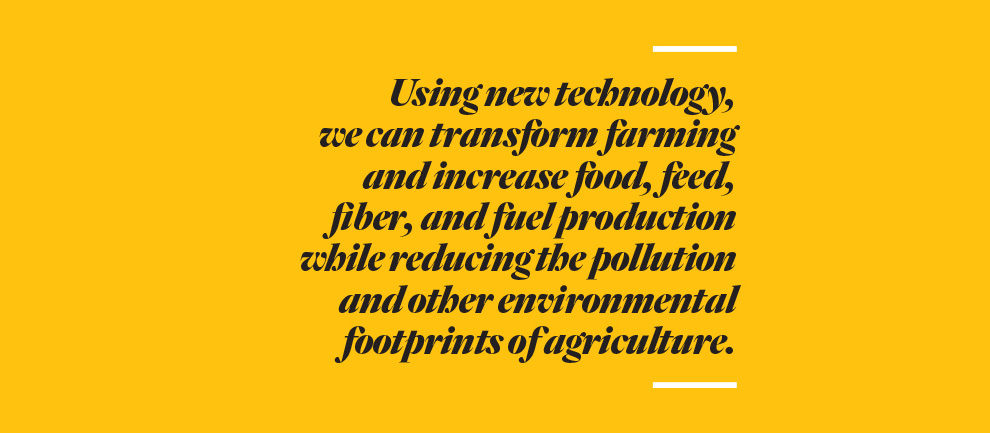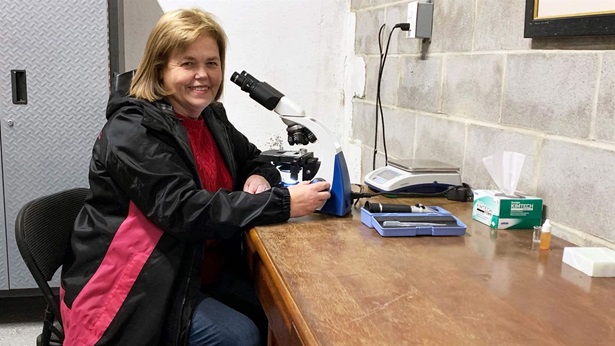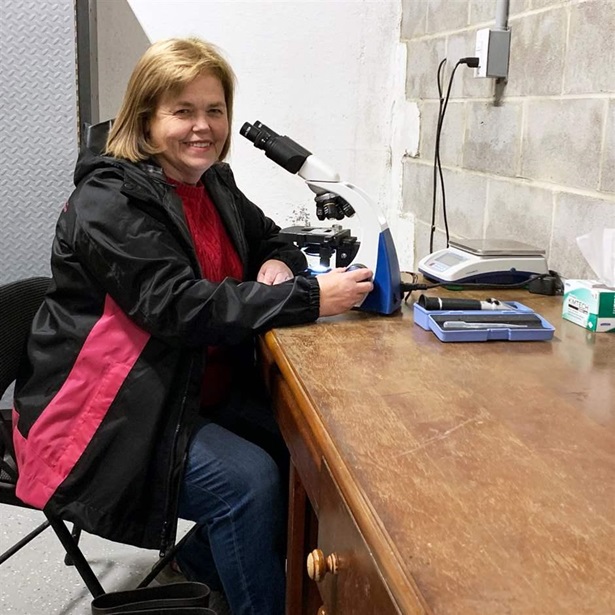Imagine a world in which each plant or animal raised for food received individual attention by robotic farmers who supply the exact amount of nutrients needed at just the right stage of growth. A farm where microdoses of pesticides are applied only on the specific insect or weed or disease posing a problem. Farmers who are able to choose seeds after tapping a worldwide database on how a plant performs in an environment just like their own.
With the need to feed a global population that the United Nations projects will hit 9.6 billion by 2050, there is some urgency to perfecting those kinds of methods. Fortunately, with the developing sciences behind precision agriculture, that world is not far off. Using big data and new technology, the potential exists to transform farming as we know it today, increasing food, feed, fiber, and fuel production while simultaneously reducing the pollution and other environmental footprints of agriculture. What’s more, precision agriculture will transform the comparative advantage of many geographic regions and force a reorganization of farm production.
Precise agriculture technologies are already well in place in the United States, Europe, and many industrialized countries. The trend began with use of GPS in the 1980s and 1990s to monitor crop yields and guide application of fertilizer. As digital technology spreads to the world’s farms, robotics, big data, and other uses of electronic information will become as common as tractors and combines. It will transform how people manage farms, vineyards, orchards, forests, and livestock. This transformation is nearly assured given technological and societal inventions in recent years.
But what is less certain is how these changes might affect local and regional agricultural cultures and labor markets. Today’s culture of food—the farm-to-table movement, the rise of organic farming, and concerns about genetically modified organisms and the use of water in some areas—includes lively debate and many policy implications. Tomorrow’s yield of dreams is therefore one that requires careful application of policy as much as technology.
A revolution in reverse
In the beginning, of course, farmers were more like gardeners, who grew crops to feed themselves and their families. Civilization’s earliest workers of the land figured out which individual plants best suited the soils on their small plots, and yields were low. But as history progressed and farmers gained scientific knowledge and mechanical expertise, they developed machinery to reduce their manual labor, chemicals to protect and nurture their crops. They brought big production methods to farming, and for some crops, yields increased tenfold from the 19th century to today.
But precision agriculture is reversing these standardized approaches and allows farmers to customize each square foot they cultivate, extracting as much value as possible from each seed.
It began in 1983, when the U.S. government made GPS technology available to the civilian sector. GPS found a ready audience among American farmers. They quickly adopted GPS guidance, mainly because it helped them to reduce the places they inadvertently missed or covered twice when applying fertilizer or pesticides, providing significant savings. According to the Purdue-CropLife survey, by 2015 almost 90 percent of fertilizer dealers used GPS guidance to custom apply fertilizer. Farmer adoption of GPS guidance has followed a similar path.
Another GPS application that has been around for several decades is “variable rate technology,” which allows farmers to apply fertilizers at different rates throughout a field. Farmers test their fields at predetermined spots to determine levels of acidity, phosphorous, and potassium, and then an agronomist maps out recommended fertilizers for each area to maximize production. A GPS-guided fertilizer spreader follows the map to apply the nutrients in the right places. But in spite of government subsidies in some parts of the U.S. and Europe, the system has yet to move beyond a 20 percent adoption rate because conducting the initial soil testing and making the recommendation map remain expensive. But researchers are working on ways to do that more cheaply, and a substantial amount of public research funding is available for site-specific soil nutrient management.
Another agricultural advancement is the development of sensors that analyze the color of a plant to determine its fertilizer needs. A plant with too little nitrogen tends to turn pale green or yellow. These sensors can be placed on the front of a tractor so that plants are scanned in motion, which would then trigger an applicator at the back of the tractor that would apply the necessary dose of fertilizer.
Drones are another new area of technology that the farm media have touted as the solution to crop scouting, management of grazing livestock, and other data collection for large-scale agriculture. In 2015, the Purdue-CropLife survey reported that 16 percent of agricultural retailers offered drone imagery services and that those retailers provided imagery on only 2 percent of their clients’ crop area, leaving drones’ cost effectiveness an open question.
While drones are the high-profile technological solution, it may instead be cheaper and easier for farmers to download microsatellite images from the internet to scan crops and gather data. Although the agriculture industry has experimented with satellite technology since the 1970s, issues such as the high cost, cloud cover, and the lag between image capture and delivery have been consistent problems. Owing to these challenges, only 18 percent of U.S. crop area is managed with satellite or aerial imagery. Microsatellites may accelerate that trend.
For example, an Argentina-based company plans to put 300 microsatellites into orbit that would provide high-resolution images of every spot on Earth every five minutes. This type of consistent and instantaneous data delivery over the internet would lower costs and increase the chances of regularly obtaining some cloud-free images even in cloudy environments.
Finally, the technology that is likely to transform farming the most is robotics. While still in its early stages industrywide, at least 8,000 dairy farms worldwide use robotic milking systems. When a cow feels the need to be milked, she is trained to enter a stall where robotic arms wash her udder, attach the milking suction cups, and detach them when she has been milked.
One of the most interesting aspects of robotic milking is that so far it tends to be used by medium-sized family farms, which adopt robotics instead of hiring and managing employees. They use robotics to leverage family labor and avoid the complexities of managing people. By contrast, very large dairy farms already have human resources departments and typically grow their production by adding more employees. Robotic milking might be one of the forces tipping the economic balance away from mega dairies toward more modest-sized family operations.
GPS also has allowed the possibility of autonomous farm equipment—just as driverless cars appear soon in the offing, manufacturers are testing tractors that don’t require people. Removing human drivers brings other changes, too, since it modifies the design criteria for farm equipment, allowing it to be much smaller.
Alternatives to conventional mechanization may be especially important for smaller farms in developing countries in Africa, Asia, and Latin America, where farm labor is increasingly scarce and expensive because young people are moving to the cities, but conventional mechanization disrupts agricultural landscapes and the communities that live in them. Creating the large fields needed for conventional mechanization often requires removing trees and hedges from fields, rerouting water courses, and sometimes relocating villages.
So imagine if a farmer in a developing country could buy a basic robot capable of planting, weeding, and harvesting for the cost of a motorbike. That robot might be a cost-effective alternative to conventional mechanization. The rapid and widespread adoption of mobile phone technology in the developing world suggests that if precision agriculture companies and researchers can develop technologies that solve smallholder farmer problems at a low cost, there is a tremendous market waiting.
Not old MacDonald’s farm anymore
The classic image of conventional mechanized agriculture is one of large rectangular fields with a minimum of trees, ponds, rocks, or other obstacles—picture the U.S. Midwest and Great Plains. And today there are even larger fields in the Australian Outback, Argentine Pampas, Brazilian Cerrado, or the Russian, Ukrainian, or Kazakh steppe.
The most successful of these converted from extensive grazing lands, managed either by nomads or large ranches. Large rectangular fields could be carved out with little disturbance of villages, and the number of people affected was relatively small.
In the future, precision agriculture will reduce the competitive advantage of these large rectangular fields, and other factors such as reliability of rainfall and distance to market may be more important in the choice of where to produce agricultural products. Areas of the developing world that are now dominated by manual, smallholder agriculture may not need to go through the difficult transition of combining fields, clearing trees and rocks, moving villages, and draining ponds and seasonal water courses. With GPS guidance and robotics, those smallholder farmers may be able to use the most advanced agricultural techniques in a landscape that will be nearly unchanged.
In the short run in the United States, precision agriculture for commodity crops means that even fewer workers will be needed for production. GPS guidance allows farmers to accomplish more and, by reducing fatigue, work longer hours, especially in peak periods. In the longer run, precision agriculture is creating a demand for more skilled workers. Already agricultural suppliers and farm equipment companies worldwide are competing for employees who understand GPS, sensors, drones, and spatial data analysis.
In the future, supervising, repairing, and maintaining robots will probably become key farmer skills. With robotics, the need for unskilled labor to weed and harvest crops should almost disappear. Because this unskilled labor is often provided by immigrants in the U.S. and other industrialized countries, there will be important implications for immigration policy and for the developing world economies that have come to rely on remittances from those workers.
In the longer run, precision agriculture will probably mean that grain and oilseed production in the U.S. will move east. In the 19th and 20th centuries, agricultural production moved west to take advantage of fertile soils with few rocks that could be organized in large rectangular fields suitable for mechanization. Fields in the east are often small, irregularly shaped, and rocky, so many were used for pasture and hay or simply abandoned. But with GPS guidance and related technologies, it becomes easier to farm those irregularly shaped fields, and the region’s reliable rainfall and proximity to markets will make them even more attractive.
Since World War II, the small farms and irregularly shaped fields of Western Europe have limited the ability of nations there to take advantage of conventional mechanized technology in grain, oilseed, and other commodity crop production. For Europe, precision agriculture in general, and GPS guidance and robotics in particular, are likely to make farms more competitive and less dependent on politically troublesome subsidies, influencing the political dynamic of the European Union.
Perhaps most of all, precision agriculture has the potential to help make farm production more efficient and better for the environment at a time when there will be more mouths to feed on Earth.







